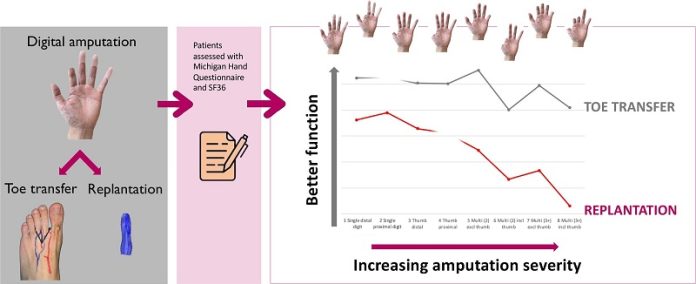
Losing a finger or thumb can be life-changing. Every year in the United States, about 45,000 people experience amputations of the digits, often leading to lasting disability—especially if the thumb is lost.
The standard treatment is to try to reattach the amputated part in an emergency procedure known as replantation.
But this isn’t always possible, and when it is, the results aren’t always ideal.
Now, new research suggests that another option—transferring one of a patient’s toes to replace the missing finger—might lead to better long-term results.
The study, published in Plastic and Reconstructive Surgery, offers the strongest evidence yet that toe transfer surgery can sometimes outperform replantation.
The research was led by Dr. Fu-Chan Wei of Chang Gung Memorial Hospital in Taipei, Taiwan, in collaboration with Dr. Steven Lo of Canniesburn Plastic Surgery Unit in Glasgow, Scotland.
The team followed patients for at least five years after their surgery, comparing two groups: 75 patients who had undergone 126 toe transfers and 52 patients who had 96 finger replantations.
The results were striking. Using a standardized survey called the Michigan Hand Questionnaire, patients in the toe transfer group reported much better hand function than those in the replantation group.
In fact, the improvement in the toe transfer group was about three times higher than the threshold considered to be clinically meaningful. The benefit was even greater for people with more severe injuries.
The study also measured overall health-related quality of life using a tool called the SF-36 score. Again, toe transfer patients came out ahead in terms of physical health. Importantly, foot function in these patients was essentially the same as in the general population, suggesting that losing a toe for the surgery didn’t cause major problems with walking or balance.
To understand why some patients did better, the researchers also carried out physical tests. They found that a wider range of motion in the hand, the ability to perform a “tripod pinch” (using the thumb and two fingers to grip, like holding a pencil), and better nerve sensation were linked to improved function. Higher physical and mental health scores overall also predicted better outcomes.
Toe transfer surgery is not a new idea—it has been performed for decades—but most previous studies focused on surgical success rates rather than validated measures of how well the hand worked afterward. This new study is one of the first to combine long-term follow-up with reliable outcome measures, giving doctors stronger data to guide treatment decisions.
The authors note that there are currently no evidence-based guidelines to help surgeons decide between toe transfer and replantation. Traditionally, replantation has been considered the “gold standard” after finger amputation. But this research challenges that assumption, showing that toe transfer can be a “viable alternative” for some patients, potentially leading to better function and quality of life.
The findings could have wide-reaching effects. Finger and thumb amputations are among the largest causes of disability worldwide.
If toe transfer surgery were more widely available and integrated into healthcare systems, it could help many people regain more of their hand’s abilities—and with it, their independence.
If you care about health, please read studies about why beetroot juice could help lower blood pressure in older adults, and potassium may be key to lowering blood pressure.
For more health information, please see recent studies about rosemary compound that could fight Alzheimer’s disease, and too much of this vitamin B may harm heart health.
Source: KSR.



